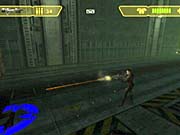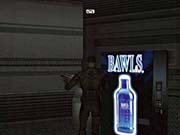RLH was an often-delayed game for the PlayStation 2 that didn't turn out so well, despite all the time it spent in development. Now, the game has now surfaced on the Xbox. Even with the addition of a new level and some downloadable Xbox Live content, the core game is still roughly the same--a sci-fi action adventure game that, much like its PlayStation 2 counterpart, feels rushed and unfinished.

The game follows the story of Nichols Conner, a military man living on the Forseti space station with his fiancée, Dr. Samantha Reilly. After a routine exploration mission with a colleague, Conner returns to the station, only to find that something has gone horribly wrong, as nearly all the inhabitants of the station, including the love of his life, are either missing or dead. Conner quickly discovers that an alien race has turned the once bustling station into a blood-and-guts-stained mess, and with the help of a hulking alien named Dag, he sets out to get to the bottom of things.
Given the source material, it's clear that RLH borrows heavily from such Hollywood blockbusters as Alien and The Thing. The space station is dimly lit and dreary, and at times it feels just about as dead as many of the people who once lived there. The invading alien forces also look very similar to the monsters in the above-mentioned movies. The game does a good job of maintaining this atmosphere throughout its course, but it really falls flat in the actual execution.
Those familiar with this type of story-driven action adventure will quickly get a handle on RLH, although they'll find that the controls are rather clunky. The Xbox version gives you a bit more camera control than the PS2 release by binding camera movement to the right analog stick, although the camera still has problems when you're in close quarters or backed in a corner. In these situations, the game will rapidly switch angles uncontrollably at the most inopportune times, such as in the heat of battle. Luckily, combat is aided by a lock-on system, so even if your target is offscreen, you'll still end up hitting the mark.
While the combat system aids you quite a bit, the game tends to throw volleys of enemies at you at a time, with most of them appearing out of thin air, one after another. Thus, with each enemy encounter, your mission is basically brought to a screeching halt until the room is cleared. Escape generally isn't an option, since the aliens pitted against you will follow you until they die. Furthermore, the game provides you with an unlimited supply of ammunition, which takes just about all the strategy out of the combat. To succeed, all you'll need to do is find a spot away from a spawn point, target your foes, and blast away. Aside from combat, the game relies on three other concepts to keep the game moving: lengthy and frequent cutscenes, simplistic minigames, and fetch quests that require you to scour every last inch of the level you currently occupy. The cutscenes wouldn't be so bad if they didn't seem like they were thrown into the game at the last minute. Some characters are lip-synched decently, while others speak out of a closed mouth, or worse still, the mouth of a marionette, opening and closing without any regard for the speech being delivered. This alone gives the game an unfinished feel. The spoken dialogue in the game is also overly dramatic and heavy-handed, much like what you'd find in a low-budget film. The minigames pop up every couple of levels, and they're simplistic at best. Most require either precise timing or button mashing, and they just break up the flow of the game even further. Once you get past all the other aspects of the game, you're ultimately left running from room to room, trying to find an important item, flip a series of switches, or collect notes with clues to a series of button combinations to open a locked door.
While the Xbox version does look generally sharper than the PlayStation 2 version, that actually isn't saying much. The character models aren't detailed, and they're created with plain-looking textures and drab colors. As previously stated, the space station is dark and lacking in any extra touches that would bring it to life. When compared with other games being released on this system, RLH clearly is a step or two behind the pack. The game also sounds about as good at it looks. The sounds of doors opening and shutting and the screams of the alien hordes are recycled over and over, and the game's score consists of brooding ambient sounds that aren't memorable in any way. One major shock comes by way of the licensed music that plays during each and every boss fight. There are a number of elements in RLH that break up the continuity of the story and the gameplay, and the music during these fights is the final nail in the coffin.
In an attempt to make the Xbox version stand out from the PlayStation 2 offering, Interplay has added an entirely new level, five additional rooms, and a couple of new monsters. These enhancements definitely aren't enough to make a poor game marginal, let alone good. On top of that, the new level just doesn't seem to fit in with the rest of the game, which is fitting, since RLH seems like it was pieced together from very different parts. Xbox Live users can also download several new minigames and new skins for various characters. While it's nice to be able to download new content, it's not that worthwhile in the long run. Ultimately, RLH is a game that simply wasn't good when it was first released, and even with slightly better graphics, a new level, and Xbox Live content, it still isn't a good game.
